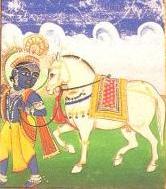Kalki
Kalki ( Sanskrit : कल्कि Kalki, also कल्किन् Kalkin ) is the tenth and last incarnation of Vishnu in Hinduism .
function
Kalki is a future avatar who, according to the Bhagavatapurana , Agni Purana , Vishnu Purana and Padma Purana, appears as the son of Vishnuyasa at the end of the present Kali- Yuga, to kill the corrupt rulers and mlecchas (barbarians) and practice the Dharma (law and virtue) restore. Then the next age, the Krita-Yuga , is to begin.
presentation
According to a South Indian folk tradition, Vishnu will appear in the form of the white horse Kalki, but according to the literary tradition of the Brahmins, he will appear as a rider with the name Kalki on the white horse Devadatta . Kalkin is extremely rarely depicted in traditional Indian sculpture; any existing paintings have not been preserved. Only in miniature painting that flourished during and after the Mughal period did he appear more frequently; his blue skin is reminiscent of Krishna .
meaning
Some Indian authors such as Aurobindo Ghose see the ten avatars as a symbol of the stages of development of human consciousness, i. H. from the animal level to the awakened spirit in its highest perfection. For them, Kalki represents the future, supramental level of consciousness.
The theosophist Benjamin Creme sees Kalki as the Hindu counterpart to the Buddhist Maitreya , the future Buddha , the Mahdi of Islam and the returning Jesus Christ . All of these figures embody the "principle of hope".
